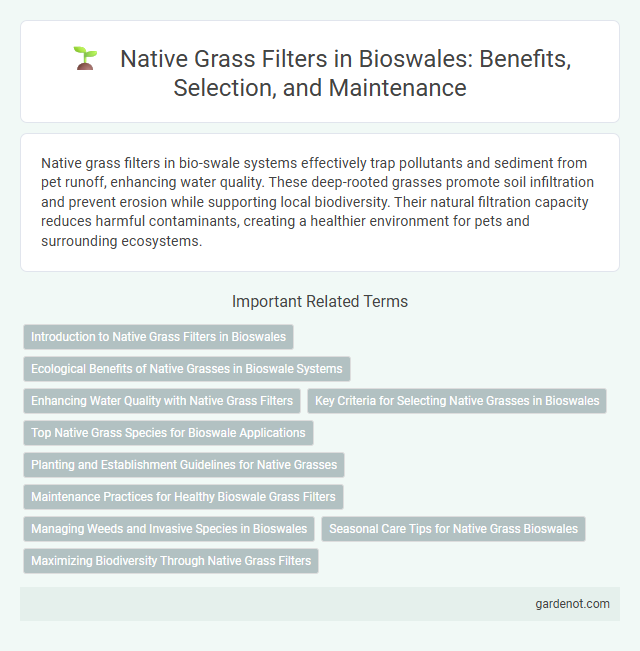Native grass filters in bio-swale systems effectively trap pollutants and sediment from pet runoff, enhancing water quality. These deep-rooted grasses promote soil infiltration and prevent erosion while supporting local biodiversity. Their natural filtration capacity reduces harmful contaminants, creating a healthier environment for pets and surrounding ecosystems.
Introduction to Native Grass Filters in Bioswales
Native grass filters in bioswales utilize deep-rooted, drought-tolerant grasses that enhance water infiltration and remove pollutants through natural filtration processes. These grasses stabilize soil, reduce erosion, and support microbial activity that breaks down contaminants, improving stormwater quality. Incorporating native grasses such as switchgrass, little bluestem, and Indian grass optimizes the bioswale's ecological functions and sustainability.
Ecological Benefits of Native Grasses in Bioswale Systems
Native grasses in bioswale systems enhance water quality by naturally filtering pollutants and sediments through extensive root networks. These grasses provide critical habitat for pollinators and wildlife, promoting biodiversity in urban and suburban environments. Their deep roots improve soil structure, increase water infiltration, and reduce erosion, contributing to sustainable stormwater management.
Enhancing Water Quality with Native Grass Filters
Native grass filters in bio-swales significantly enhance water quality by trapping sediments, pollutants, and excess nutrients from stormwater runoff. Deep root systems of native grasses improve soil infiltration and prevent erosion while facilitating microbial processes that break down contaminants. This natural filtration system reduces urban water pollution, contributing to healthier aquatic ecosystems and sustainable watershed management.
Key Criteria for Selecting Native Grasses in Bioswales
Key criteria for selecting native grasses in bioswales include drought tolerance, root depth, and soil stabilization capabilities. Species such as Little Bluestem (Schizachyrium scoparium) and Switchgrass (Panicum virgatum) excel in water filtration and erosion control due to their extensive root systems. Adaptability to local climate and native biodiversity support enhances the ecological benefits and long-term sustainability of the bioswale.
Top Native Grass Species for Bioswale Applications
Top native grass species for bioswale applications include switchgrass (Panicum virgatum), little bluestem (Schizachyrium scoparium), and blue grama (Bouteloua gracilis), known for their deep root systems and drought tolerance. These grasses enhance pollutant filtration by stabilizing soil, increasing infiltration rates, and promoting microbial activity that breaks down contaminants. Their adaptability to local climate and minimal maintenance requirements make them ideal for sustainable stormwater management in bioswales.
Planting and Establishment Guidelines for Native Grasses
Planting native grasses in bio-swales involves selecting species adapted to local climate and soil conditions, ensuring optimal water filtration and erosion control. Establishment requires preparing the soil by removing weeds, loosening the substrate, and applying mulch to retain moisture while promoting root development. Regular monitoring during the first growing season supports successful establishment by managing competing vegetation and providing supplemental watering as needed.
Maintenance Practices for Healthy Bioswale Grass Filters
Regular mowing at optimal heights prevents native grass filters in bioswales from becoming overgrown, maintaining their filtration efficiency and aesthetic appeal. Periodic removal of accumulated sediment and debris ensures unobstructed water flow and promotes healthy root development. Implementing seasonal inspections helps detect pest infestations or diseases early, enabling targeted treatments to sustain vigorous growth and pollutant removal capabilities.
Managing Weeds and Invasive Species in Bioswales
Native grass filters in bioswales effectively manage weeds and invasive species by promoting dense root systems that outcompete unwanted plants for nutrients and water. These grasses support native biodiversity and improve soil stability, reducing erosion and preventing invasive species establishment. Regular monitoring and selective maintenance ensure the dominance of native species, enhancing the bioswale's ecological function and water filtration capacity.
Seasonal Care Tips for Native Grass Bioswales
Native grass bioswales require seasonal care to maintain optimal filtration and erosion control, with spring involving the removal of debris and light pruning to encourage new growth. Summer care focuses on deep watering during dry spells and monitoring for invasive species to preserve native plant health and functionality. In fall, cutting back dead foliage and applying mulch supports soil moisture retention and prepares the bioswale for winter dormancy.
Maximizing Biodiversity Through Native Grass Filters
Native grass filters in bio-swales enhance biodiversity by supporting a wide range of local flora and fauna adapted to the specific ecosystem. These filters improve soil health and water quality by efficiently trapping pollutants while providing habitat for native pollinators and beneficial insects. Incorporating diverse native grass species maximizes ecological resilience and promotes sustainable drainage solutions in urban landscapes.
Native grass filter Infographic

 gardenot.com
gardenot.com